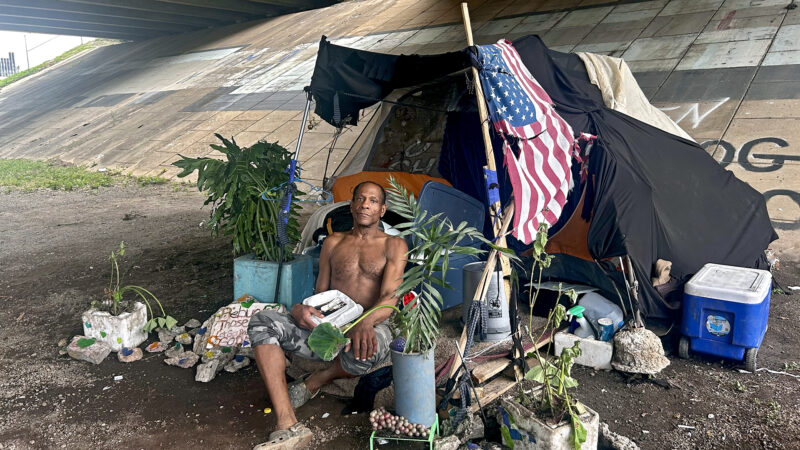‘Where’s Jeff?’: Unhoused and struggling with opioid addiction in Birmingham
Julius, one of Suzanne Smith’s people, sits by his encampment with his plants in Birmingham, Alabama. Julius loves tending his garden, rescuing dying plants and nursing them back to life. Suzanne took this photo of Julius after stopping by for a visit.
On a Saturday night in Birmingham, Alabama, Suzanne Smith loaded up her SUV with bags of clean needles, fentanyl test strips, bandages, antibiotic cream, clothes and other supplies and drove downtown to look for “her people.”
All night long, checking under bridges, near dumpsters, behind gas stations, on church steps, rifling through empty tents on the side of the road, the question on her mind was, “Where’s Jeff?”
For the last five years, Suzanne worked as a peer support specialist for the University of Alabama at Birmingham, using her lived experience to connect with people living on the city’s streets who struggle with addiction. She’s been in recovery for more than 20 years.
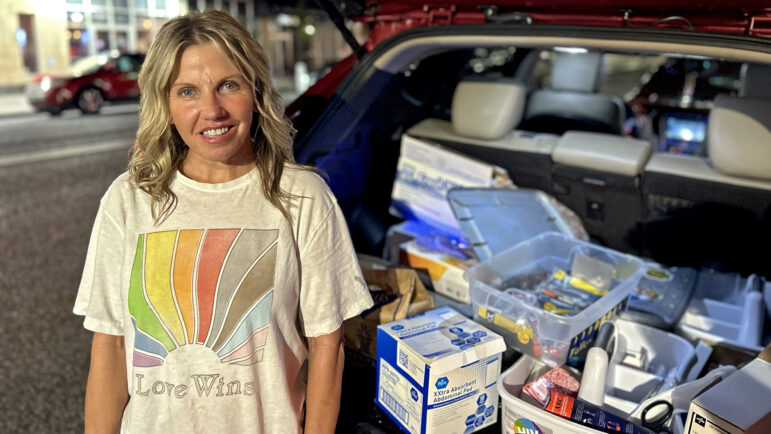
The last time she found Jeff, he was lying on the ground, covered in his own feces and badly injured. He’s disabled and said he’d been beaten by the Homewood Police Department, a suburb of Birmingham.
In a cell phone video she took, Jeff told Suzanne that police officers took his belongings, including the walker he uses to get around.
“Why did they pick you up?” Suzanne asked him.
“For flying,” Jeff said — slang for holding a sign at an intersection asking for money.
Jeff had a serious infection on his leg, caused by injecting xylazine, a sedative intended for veterinary use that is sometimes mixed with other drugs, like heroin or fentanyl. It can cause skin ulcers that turn necrotic. “Zombie-like,” some describe it.
Suzanne could see his femur bone. But Jeff wouldn’t go to the hospital because he was worried he’d be labeled as a drug user and wouldn’t receive pain medication. He was worried about the withdrawals.
“If you test positive for any illicit substance, the first line — and I know this because I worked at the hospital — the first line you read about that patient is polysubstance abuse,” Suzanne said. “You’re stamped. You’re tagged as a drug seeker, a drug user.”
As a last resort, Jeff had turned to a practice used for centuries to treat wounds. He slept near a dumpster with flies nearby, letting them land on his leg to lay their eggs and allow the maggots that developed to eat at the dead flesh.
This desperate measure might have saved his life.
Suzanne put his leg in a biohazard bag, zip-tied it as tight as she could and took him to the hospital. When they arrived, they were told they would have to wait.
“I told them you do not want him to wait,” she said.
So, she cut the zip tie off, showing the medical staff Jeff’s leg.
“He didn’t have to wait anymore.”
Jeff was admitted and Suzanne stayed with him, advocating and begging the staff to give him methadone to help with his withdrawals, which they did.
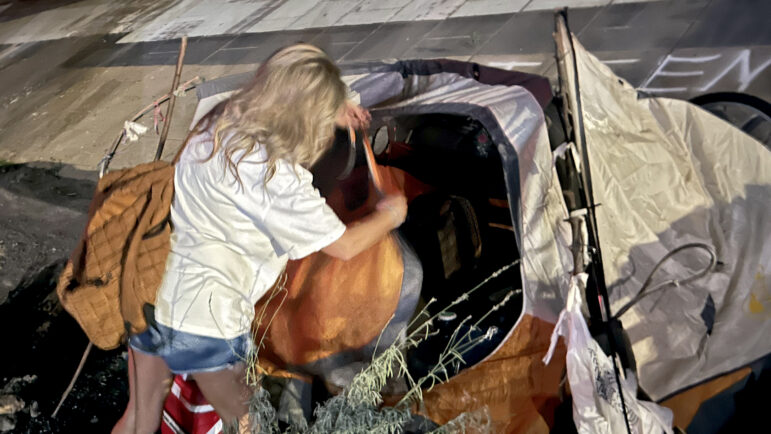
Methadone is a prescription drug that’s been used since the 1950s to treat Opioid Use Disorder (OUD). It’s also one of the most effective forms of treatment, reducing withdrawal symptoms and cravings for opioids.
Methadone and drugs like buprenorphine and naloxone are all part of a family of drugs called Medications for Opioid Use Disorder (MOUD). They can be difficult to access for unhoused people in the city because they require a state assessment, which is almost impossible if you don’t have a phone or car. You also have to go to a methadone clinic every day to receive treatment, of which there are only a few in the city and they’re sometimes miles away from the nearest bus stop.
Recently, Alabama announced it would send $8 million from the state’s latest round of opioid settlement funds from a lawsuit against manufacturers and distributors, like Cardinal Health and McKesson, and pharmacies, like CVS and Walgreens, to organizations working in prevention, treatment and recovery support for addiction. This, however, is a small fraction of the almost $100 million the state has received so far.
Suzanne said this money could help more of the people she works with — people like Jeff. After he was released from the hospital, Jeff was placed in a shelter for unhoused people and connected to a methadone clinic. But he didn’t have any assistance with transportation, and the nearest bus stop was a mile from the clinic.
Still, Jeff tried. Already disabled, recovering from the wound on his leg, and without his walker, he limped — sometimes crawled — the distance from the bus stop to the clinic to receive his daily dose of methadone. Eventually, without insurance that would pay for the medication, and with the trip becoming too difficult, Jeff relapsed and was kicked out of the shelter, back onto the street.
“There were no grants, no funds, no scholarships to apply for,” Suzanne said. “After the state of Alabama had just been awarded all this money. There were no opioid settlement funds that would help.”
It’s been over a week since Suzanne has seen or heard from Jeff. She’s worried. You can hear it in the way she talks, the way she cranes her neck to look around as she drives — like she’s trying to see everything and everywhere all at once, hoping to see him.
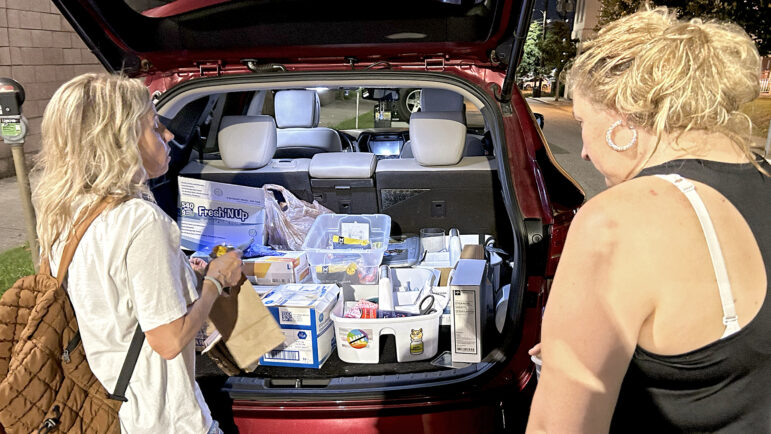
As she drove around, Suzanne called more of her people, asking where they were and writing it down so she could meet them later.
Recently, Suzanne was fired from her job at University of Alabama at Birmingham Medicine for taking blankets and bandages from the clinic where she worked to give to people on the street.
But she still comes out every night.
“I’ve just been spending my own money that I don’t have — and now I really don’t have, because I don’t have a job,” she said with a laugh.
She does that. Punctuates heartbreak and despair and grief with laughter. It veers on the edge of cynicism and irony — something between wry and sardonic. It’s heavy and sweet. It knows. It’s been there.
The day she was fired, Suzanne told one of her people. Within 24 hours, everyone knew about it. Word travels fast.
In every call she made from the SUV, her people asked her about her job: What’s going on with it? Has anything changed? Are you OK? What are you going to do?
They were worried about her.
And in every call, she asked, “Have you seen Jeff?” No one knew where he was.
Parking under the Second Avenue South bridge, Suzanne said she’s not afraid at all. They all know her. They’ll see her SUV and know she’s here to help.
A moment later, she spotted Roy — one of her people. Roy’s older, in his mid-60s. He was sitting in a camping chair next to his tent, his leg propped up and wrapped in a bandage.
Suzanne asked him if he needed any supplies. He did. She asked if she could look at his leg. She could. She asked if he’d seen Jeff. He hadn’t.
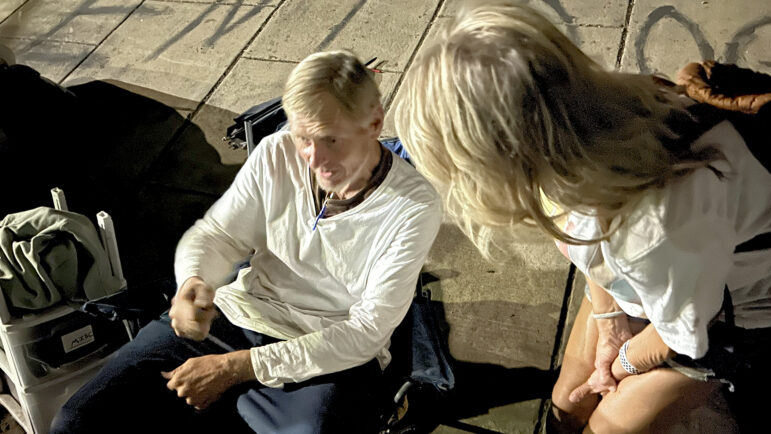
A few weeks before, Roy had been attacked by another unhoused person with a baseball bat. His leg was doing better, but at one point, it was badly infected. He went to a doctor.
“They said we’ll put you on antibiotics, but we’re going to have to amputate because by that time it was getting gangrene,” he said.
Like Jeff, Roy resorted to using maggots, too.
“In the 1800s, if somebody got shot, a lot of times they would use what they could to clean and get the infection off — flies, leeches, and whatnot,” he said. “So that’s exactly what I did. I cleaned it, wrapped it loose, went somewhere and there was a couple of flies flying around, so I let them land on it.”
Suzanne kept him supplied with clean bandages and clean needles — Roy has been using fentanyl for years. He called Suzanne an angel several times. His face brightened up when he first saw her. They sat and talked for half an hour — about life, about friends who overdosed, about politics, about the future. Roy had a potential job lined up he was excited about.
Before she left, Suzanne pulled out another bag and shook it up, the contents jingling around inside. She reached in and pulled out a little block with an inspirational quote — she picked up dozens of them from the dollar store. She handed it to Roy. He squinted his eyes to read it in the darkness beneath the bridge.
“It says, ‘Your greatest creation is always going to be your life story.’” He smiled. Suzanne cheered and laughed.
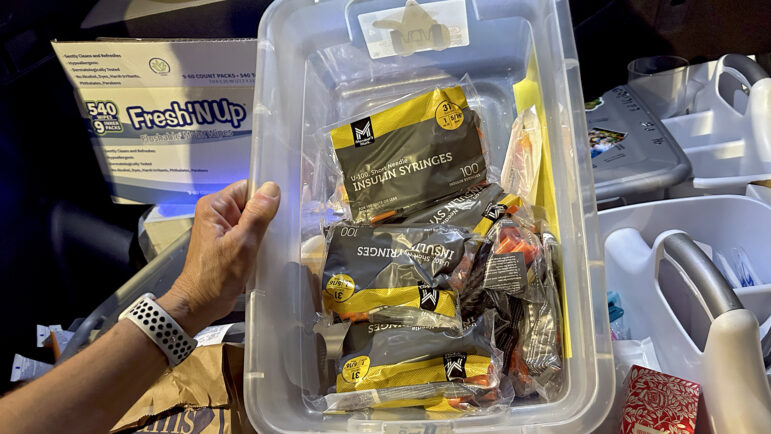
Suzanne got back into her SUV and drove to the next location, a gas station. There, she met Rodney and Don. They emerged from the shadows at the sight of her vehicle, big smiles on their faces. She gave them some shirts and pants she’d picked up at a thrift store, along with a bag of supplies.
“That’s an angel out here to us,” Don said.
“She really is,” agreed Rodney.
The two men often sleep out in the woods on Red Mountain, coming down into the city to fly signs and try to scrounge up enough money to eat and stave off their withdrawals. They both use fentanyl and have both struggled to stay in treatment.
But they both want to stop using. They’ve watched too many friends overdose and die. They’ve tried several times but said that without support, it’s “impossible” to stay in recovery.
“I can’t do regular detox,” Don said. “I got to use medical detox. I’ve been using so long, it might kill me.”
“And it’s not only the medical part of it, but it’s what happens afterward,” Rodney added. “Being able to stay somewhere for a good month or so. And really, that’s too short. We’ve been out here for years. But a month would be awesome. Stay somewhere and stay clean.”
Suzanne stayed with them for another half-hour. They catch up. Joke about the University of Alabama football team — debating whether they’ll make a championship run this year.
She handed each of them a block with a quote on it.
“It takes a journey through the dark to fully appreciate the light,” Don read.
Rodney chuckled and shook his head and said his was too cheesy. Still, he read it aloud with a big smile on his face: “Remember, every setback is just a setup for a comeback.”
As she hugged them to leave, Suzanne asked them both, “Have you seen Jeff?”
They hadn’t in over a week.
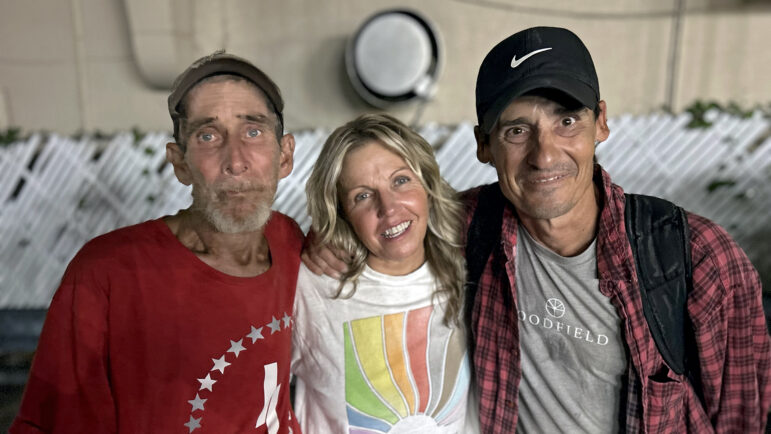
On to the next spot: a large marble church in downtown Birmingham. A group of people hang out in the shadows of the top landing, the flick of lighters and the flash of flame illuminating the dark space for brief moments.
Fearless, Suzanne walked to the bottom and called out to the unknown figures.
“Hey kids, how’s it going?”
Sitting on the top step of the landing, she found her friend Blair. Asked if she needed supplies. She did. Blair walked with her back to her car, where Suzanne opened up the trunk and gave her a “care package,” as she called it: syringes, Coban wrap, antibiotic cream, bacitracin, fentanyl test strips, tampons, sanitary wipes.
“She’s a godsend, a real-life angel,” Blair said, hugging Suzanne.
Blair’s story epitomizes the opioid epidemic — which is what the settlement funds are intended to help alleviate.
There are three waves to the crisis: Blair started taking prescribed pain medication — OxyContin — after a botched breast reduction surgery. She became dependent after being overprescribed to those pain pills. That’s wave one.
When the pills dried up, after a crackdown on overprescriptions that rarely included plans to taper or assist people who’d become addicted to them, she moved to heroin. That’s wave two.
And when cheaper, stronger, synthetic opioids like fentanyl flooded the streets, the third wave washed over her. She said she lost everything.
“I had a wonderful marriage, great children, a wonderful home life, a beautiful house, everything I ever dreamed of,” she said through tears, her voice cracking. “But I had this addiction to this medicine and I couldn’t stop taking it and I didn’t know why.”
Before she left, Suzanne asked Blair if she’d seen Jeff. She hadn’t. Then, she reached into her bag of inspiration and handed her a block.
“You are never too old to dream a new dream,” Blair said. She laughed. “Of course, an old lady like me would pick this one, right?”
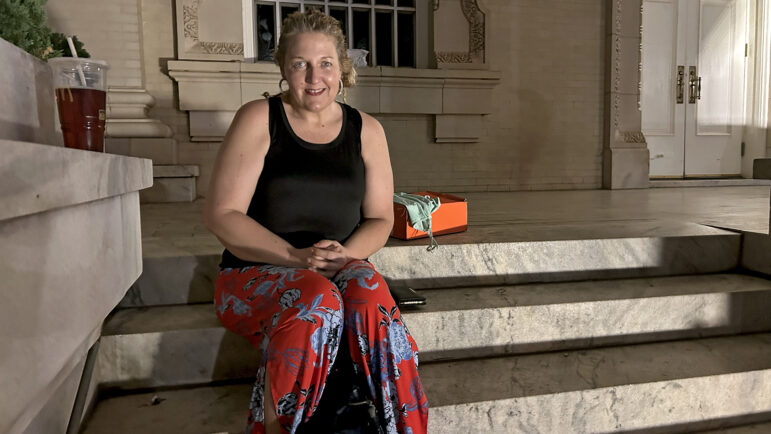
Like the others, Blair wants to get treatment. She wants to stop using, but going to a clinic every single day is almost impossible — especially if she wants to hold down the job she recently started working. The clinic opens at 9 a.m. and closes before she gets off of work. She said it’s hard to explain to her managers why she would have to be late or leave work during the day.
“Everybody’s not understanding. Everybody doesn’t understand that you’re trying to do what you can to stay healthy and try to get this monkey off your back. But it’s so hard,” she said. “I never thought I’d be anywhere like this. I never fathomed my life being like this.”
This difficulty in accessing and staying in treatment supported by medications like methadone is something local doctors see as well. Dr. Ellen Eaton, an associate professor of medicine at UAB who works with unhoused people, said the first thing she has to ask is whether a patient has access to a vehicle.
The patients who have left her clinic in hopes of getting better control of their OUD with methadone have all come back because they were unable to keep up with the financial and transportation requirements — despite many of them saying methadone helped with their cravings and chronic pain.
“I’ve heard my patients say, ’As long as it’s easier for me to get heroin or fentanyl than it is to get methadone, I’m going to pick the heroin or fentanyl.’”
Eaton echoed Suzanne’s sentiments that Alabama’s opioid settlement funds could be a real game changer for people living on the streets who struggle with addiction. It could help support people who want to be in recovery but have barriers, like medication costs, transportation and housing issues, stacked against them.
The problem, Eaton said, is that it’s not clear where that money is going. Alabama isn’t required to report how it’s spending the funds.
“I don’t have a great sense of where it’s going in my state either. I don’t have a great sense of where to refer for my patients,” Eaton said. “Gosh, wouldn’t that be great if I knew which nonprofits have received funding so that I could refer my patients for housing or counseling? But I truly don’t have a good sense, either.”
If she had a magic wand, Eaton would use the money to support treatments and resources that have been proven effective through research and data — what she called “evidence-based tools.” And as the settlement money continues to roll in over the coming years, so will the public health data. States where more people are receiving medication for their OUD may show notable downturns in things like fatal and non-fatal overdoses, she said. These may become indicators that support evidence-based tools — like methadone.
I’ve heard my patients say, ‘As long as it’s easier for me to get heroin or fentanyl than it is to get methadone, I’m going to pick heroin or fentanyl.’
Dr. Ellen Eaton, UAB Medicine
In the meantime, people like Suzanne are their last line of defense for many people living on the street struggling with addiction.
She spent the rest of the night driving to the usual spots, looking for her people who don’t have phones. She found a few more, but she didn’t find Jeff. Not until the next day.
He was in the woods off the side of the road. He’d been using xylazine and had developed another infection on his leg. The skin was rotting and sloughing off. He smelled like death. Again, he had maggots eating the necrotic flesh. Again, she took him to the hospital. Again, they were told they had to wait. Again, she showed them his leg.
Jeff was admitted and stayed for a few weeks. Then, the police came and tossed his room, searching for drugs. He didn’t have any. They ordered the hospital not to allow visitors — to keep out his unhoused friends. So, he left.
He got into a shelter and started taking methadone again. Suzanne has met up with him almost every day for the last few weeks. He takes the bus and limps to the clinic for his daily medicine.
But she’s still worried about him. She said she knows when he’s getting antsy. And if he can’t keep getting methadone, he’ll go back to fentanyl. And she’s worried if he does, he’ll overdose, and she’ll lose him forever.
For now, when she needs to find him, she checks the shelter. And if she goes there one day to look for him and he’s not there, she’ll go back to her people and ask around until she finds him again.
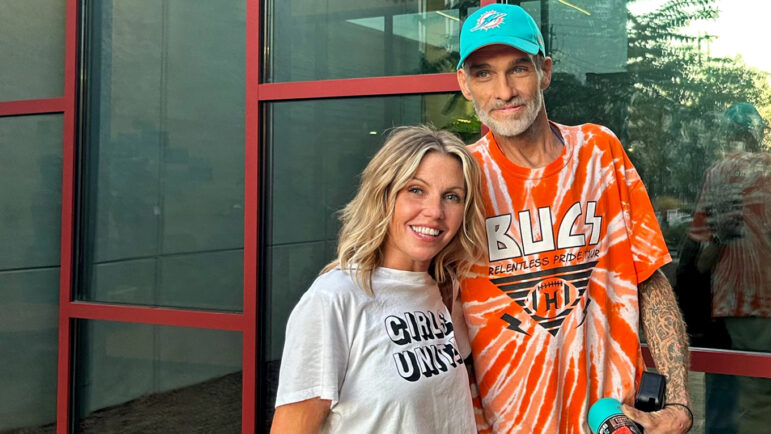
This story was produced by the Gulf States Newsroom, a collaboration between Mississippi Public Broadcasting, WBHM in Alabama, WWNO and WRKF in Louisiana and NPR. Support for health equity coverage comes from The Commonwealth Fund.
Editor’s note: UAB holds WBHM’s license, but our news and business departments operate independently.
Jeffrey R. Holland, next in line to lead Church of Jesus Christ of Latter-day Saints, dies at 85
Jeffrey R. Holland led the Quorum of the Twelve Apostles, a key governing body. He was next in line to become the church's president.
Winter storm brings heavy snow and ice to busy holiday travel weekend
A powerful winter storm is impacting parts of the U.S. with major snowfall, ice, and below zero wind chills. The conditions are disrupting holiday travel and could last through next week.
Disability rights advocate Bob Kafka dead at 79
Bob Kafka was an organizer with ADAPT (American Disabled for Attendant Programs Today), a group which advocates for policy change to support people with disabilities.
‘It’s behind you!’ How Britain goes wild for pantomimes during the holidays
Pantomimes are plays based on a well-known story — often a fairy tale — which are given a bawdy twist. The audience is expected to join in throughout, shouting as loudly as they can.
Kennedy Center vows to sue musician who canceled performance over Trump name change
The Kennedy Center is planning legal action after jazz musician Chuck Redd canceled an annual holiday concert. Redd pulled out after President Trump's name appeared on the building.
Our top global photo stories from 2025: Fearless women, solo polar bear, healing soups
These stunning photos include a polar bear in a Chinese zoo, a teen in Zambia facing an uncertain future, Mongolian kids watching TV in a tent, a chef prepping a bowl of good-for-you soup.

